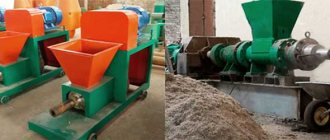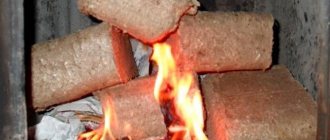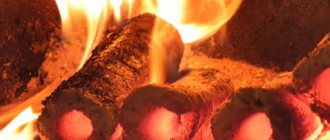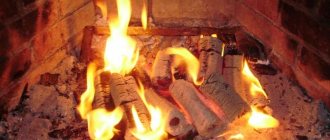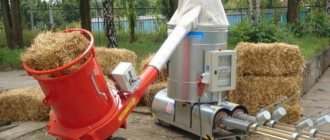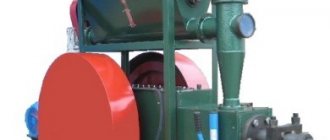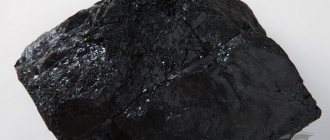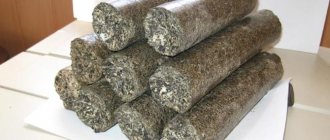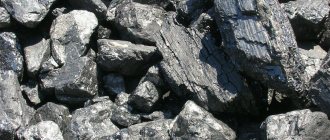Fuel briquettes, also known as Euro-firewood, are today a successful alternative to firewood and coal. Affordability, versatility and other advantages make them an excellent type of solid fuel. They are actively used both for stoves and boilers, and for fireplaces. In this article I want to talk about wood fuel briquettes, and also mention peat analogues.
Fuel briquettes
BUY FUEL BRIQUETTES
How are fuel briquettes produced?
The raw material for this type of fuel is wood processing industry waste. In addition, peat and straw are also used as materials due to their energy value. No glue is used in production; the briquettes contain no foreign binders.
However, the “bricks” hold their shape well and remain hard. At the beginning, the raw material is crushed, which allows it to be effectively dried and then compressed. When sawdust is heated, a natural substance is released - lignin. It is this that allows the wood particles to be bonded together during pressing. It is absolutely safe for humans and the environment. Thanks to lignin, Euro firewood is produced without additional gluing components.
Rules of use and precautions
Bioethanol, which is part of biofuel, is a particularly flammable substance, and when using it, you must follow and observe certain safety measures:
- Never add fuel to an open flame or a fuel tank that is not cool. Before refueling, it is necessary to extinguish the device and wait for it to cool (about 15-20 minutes).
- It is prohibited to use straw, paper, wood or other flammable materials to ignite biofuel. It is allowed to use only a special long metal lighter, electric ignition or long match.
- It is prohibited to store fuel canisters near a burning fireplace or other source of open flame.
- It is recommended to store biofuel out of the reach of children.
- If fuel is spilled during the process of refueling the biofireplace, it must be thoroughly wiped off with an absorbent cloth.
General operating rules:
- It is necessary to store the container with biofuel in a place away from open fire and heating devices.
- Ignition of biofuel in the burner should be done with a special lighter.
- If biofuel gets on the surface of the biofireplace, the floor or any other surfaces, the drops must be thoroughly wiped with a dry absorbent cloth.
- Biofuel can only be added to an extinguished and cooled eco-fireplace.
In order for an eco-fireplace to please its owners with an even and pleasant burning, it is necessary to properly supply it with high-quality fuel.
There are several criteria that will make it extremely difficult to make a mistake with your choice.
- First of all, you need to choose fireplace products that have been on the market for more than one year and have proven themselves well. The seller must have the necessary documents for biofuel on hand.
- It is also worth paying attention to the performance indicator and choosing a biofuel that will meet the needs of the fireplace owner.
- When opened, the liquid should not emit unpleasant odors that hit the nose sharply. It is important that the expiration date stated on the label has sufficient remaining time remaining.
Only by choosing high-quality products can you be sure that an ecological fireplace will decorate your home and operate as safely as possible.
Advantages of fuel briquettes
If we compare fuel briquettes with the firewood we are used to, we cannot help but note the following advantages of the former:
- High combustion temperature. Firewood burns on average 2 times weaker than fuel briquettes. This is due to their high humidity (about 15-20% subject to storage conditions) and low density. Therefore, their calorific value is significantly lower: approximately 2500 kcal/kg versus 4500-5000 kcal/kg, which are produced when burning briquettes. The latter undergo not only thorough drying, leaving only 5-8% moisture, but also pressing. The combination of high density and low humidity gives briquettes a higher combustion temperature.
- Uniform and long burning. Surely everyone who has burned ordinary wood has noticed the following drawback: a decrease in heat transfer during combustion. In comparison, fuel briquettes burn 3 times longer, while constantly releasing heat. Thanks to such uniformity and long burning, briquettes are consumed much more economically.
- Safe for the environment and humans. Fuel briquettes are produced from waste, which will be a plus for those who care about the environment. At the same time, when burning, they emit little smoke, almost no smell and do not spark. They leave little soot behind, making cleaning faster and easier.
- Compact. Euro firewood is really easy to store, as it has a standard shape and small size. Unlike coal and firewood, each batch of briquettes is similar in size to the previous one. Despite their considerable weight (from 10 kg per package), these “bricks” are quite compact.
Fuel briquettes are compact
Kinds
The method of processing raw materials plays an important role. Taking into account the manufacturing process, briquettes can be divided:
- Piny-kay. Fuel having the highest density of 1.40 g/cm3. The shape is similar to a cube or hexagon, which has a hole in the middle. The air inside the cavity ensures even combustion.
- Low density products – 0.8 g/cm3. These are squares or rectangles made from the smallest particles of material. They are characterized by high thermal conductivity and long-lasting combustion. Convenient to store and transport, do not take up much space.
- Products made from large sawdust with medium density. Their disadvantages include rapid combustion, frequent loss of shape and deformation. Due to low production costs, they have a relatively low price.
Disadvantages of fuel briquettes
Of course, fuel briquettes cannot be perfect for every user. They also have their disadvantages in comparison with the same coal or firewood.
- Lack of moisture resistance. Euro firewood is afraid of water and crumbles when exposed to moisture. When opening the original packaging, you should immediately make sure that the fuel is stored in a dry place where it is not humid.
- They take a long time to flare up. Unlike firewood, briquettes need time to ignite and begin to give off heat. Therefore, it will not be possible to warm up the room quickly with them.
- Not so aesthetically pleasing. We are talking about the cozy crackling of burning wood and the beautiful flame in the fireplace. Fuel briquettes do not burn as beautifully. This is not such a significant minus in comparison with the previous ones, but it is also worth taking into account.
Biofuel for the fireplace
Biofuel is a type of fuel from biological raw materials, produced from waste products of organisms, from animal or plant raw materials, or as a result of processing biological waste.
Biofuel for fireplaces is the best type of fuel that does not require the presence of a chimney. Suitable for eco-fireplaces.
The prefix “bio” arose as a result of the use of renewable plant resources in production.
At its core, fireplace fuel is denatured ethanol made from regular ethanol.
Ethanol is an alcohol produced during the fermentation of plant sugar-containing crops (beets, potatoes, cane sugar, wheat).
You can also obtain pure alcohol by hydrolyzing raw materials with a high cellulose content (straw, wood).
According to international rules, free retail sale of pure alcohol is prohibited. Therefore, biofuel for fireplaces is produced by denaturing ethanol.
During the denaturation process, ethanol becomes environmentally neutral.
Biofuel for fireplaces does not have a harmful effect on the human body or other animal organisms.
The combustion of ethanol is accompanied by its decomposition with the formation of carbon monoxide, steam and some heat. During the combustion process, beautiful, even tongues of fire are formed.
Ecological fuel is absolutely safe, burns without soot, odor and smoke. Due to this, there is no need to install a smoke hood and heat is not lost, but is retained in full in the room.
Thus, the efficiency of biofuel is 95%. The appearance of the flame produced by burning biofuels is practically no different from the appearance of burning logs. The use of biotollive in the form of a gel containing sea salt allows you to enjoy the complete illusion of fire with the characteristic crackling of real firewood.
There are several types of such fuel, among which it is worth noting:
- biogas;
- biodiesel;
- bioethanol
To produce biodiesel, vegetable fats are used, as well as some animal products. Rapeseed, coconut, palm, soybean, etc. oils are usually used as a production resource.
Many plant and animal components are obtained from food industry waste. This product is usually used for transport work.
Bioethanol is considered as an environmentally friendly analogue of gasoline.
The product is obtained through the fermentation of carbohydrates, the source of which is raw materials with a high content of starch, sugar or cellulose. To produce biogas, waste of organic origin is literally used, which is decomposed by bacterial cultures.
Bioethanol, which looks like a colorless, odorless liquid, is created on the basis of alcohol. Alcohol for creating fuel is obtained from carbohydrates found in sugar, which is the key to the naturalness of the product. Sugar is extracted from cane, potatoes, beets, and corn. Ethanol can be produced from wood raw materials that contain cellulose.
Eco-fireplaces use denatured ethanol. It is formed as a result of the fermentation of wheat, cane sugar, beets, potatoes, etc.
Ethanol is also produced by hydrolyzing wood, straw and other high cellulose content resources.
The combustion process of such practically pure alcohol is not accompanied by the release of soot, smoke and other products.
Biogas fuel produced from human waste and considered an analogue of natural gas. Used mainly for industrial purposes.
Advantages of biofuels:
- Environmentally friendly biofuel does not emit harmful substances, burning, soot, soot, smoke or other gases into the air during combustion.
- Fireplaces for apartments using biofuel do not require the installation of a hood or chimney, since they are simply not needed.
- Since there is no chimney or exhaust hood, all the heat enters the room. Additionally, the air in the room is humidified, because When burning, water vapor is released.
- Bio-fireplace burners from biological fuel practically do not get dirty, and small stains are easy to clean.
- The level of liquid combustion in the fireplace can be adjusted, this is especially easy with a gel composition.
- Biological fireplaces are considered fireproof devices because they have a thermally insulated body. The installation of such devices is simple; they are easy to assemble and disassemble.
- Unlike firewood, biofuel does not leave behind any waste and can be purchased at any time. In addition, the price for this type of fuel is quite affordable.
There are also disadvantages, but they are few:
- the power of a biofireplace is not enough to heat a very large room;
- despite the general safety of use, a real live open flame burns in the eco-fireplace - and it cannot be left unattended;
- You cannot add fuel while it is burning; you must put out the fireplace and wait for it to cool completely;
- Do not store biofuel near an open fire source;
- It is strictly not recommended to ignite biological fuel using paper and logs; special iron lighters are used for this.
A little about the cost
At first glance, it may seem that fuel briquettes are unprofitable from a financial point of view in comparison with firewood. The cost of the same weight of these types of fuel varies almost twice, and not in favor of briquettes. However, it is worth considering that one batch may contain firewood of different quality, including high humidity and porosity.
Thanks to the manufacturing technology, each briquette in the package has the same density, and its moisture content is no more than 9%. On average, 1 cubic meter of briquettes is equal to 4-5 cubic meters of the same birch firewood. Therefore, they are more profitable both in terms of characteristics and price.
Fuel briquettes burn for a long time and with high quality
Fire wood stoves
Wood-burning stoves provide efficient heating of residential and non-residential premises. They are presented in many models, differing in their technical characteristics and design. They use the most ordinary firewood as fuel - they can be purchased by the truckload. But this fuel cannot be called modern and efficient. And today it has been replaced by fuel briquettes for heating stoves.
To clarify, let's look at the main disadvantages of traditional wood fuel:
Ordinary firewood must first be chopped and then placed in neat woodpiles. This is a very labor-intensive and time-consuming process.
- It is inconvenient to stack firewood in neat stacks - if they are the same size and format, then this is not so bad. But if some logs are thin, while others are thick, and even knotty, then the masonry will be crooked and oblique (although a lot here depends on the “curvature” of the hands);
- Firewood needs to be split - it often comes in the form of round logs that require chopping. Swinging an ax in cold weather is a dubious pleasure (although useful);
- Firewood is often damp - seeking for their own profit, lumberjacks sell the wood in a raw state, without first drying it. Compared to almost dry fuel briquettes for heating stoves, they will not be easy to light;
- Low calorific value - a cubic meter of firewood produces less heat than the same wood briquettes of the same volume ;
- Firewood produces a large amount of ash - the same wood briquettes practically do not clog the stoves;
- Wood burns with clicking and crackling sounds, burns unevenly, clearly inferior to briquettes in this regard.
Firewood is the most common and cheapest solid fuel for heating stoves and boilers. But fuel briquettes are superior to them due to their convenience and high calorific value.
Coniferous or birch?
At the end, any European firewood has approximately the same density, regardless of the wood species used. Oak briquettes have a higher rate. However, this does not mean that they are necessarily better in quality.
Since conifers are not as dense, it is easier to make fuel briquettes from them. The production cost is lower, which allows you to sell European firewood at a lower cost. Therefore, pine briquettes are often slightly cheaper than their birch and oak counterparts.
It is believed that such European firewood burns better and cleaner due to the resins they contain. Their heat transfer rate is slightly higher, that is, they produce more heat. However, the ash content of this option is higher. The ash does not burn, but remains in the oven. Chimney maintenance when using pine briquettes should be more thorough. This is all due to the above-mentioned resins and ash, which do not burn completely, but remain on the bottom and walls of the furnace.
Unlike their coniferous counterpart, hardwood briquettes contain less ash, and therefore there are fewer by-products from them. They leave no ash behind, no unpleasant odor, and the chimney remains clean longer.
At the same time, it will not be possible to detect any significant difference in the calorific value of coniferous and hardwood briquettes. Therefore, you should rely solely on your preferences and willingness to more carefully monitor the condition of the stove.
What briquettes are best to use?
Different types of briquettes have different calorific values. This feature should be taken into account when choosing a product, because it is the most important. Sawdust briquettes are considered the best option.
These fuel briquettes are best for a stove in a house, bathhouse, cottage or other room. They have high heat transfer, burn for a long time, leave little ash, are easy to use and transport, and do not pollute the air.
Briquettes of sunflower seeds and coniferous husks also have good performance, but due to the presence of oils they pollute the chimney. As a result, the heating device will require frequent cleaning.
Before purchasing, pay attention to the structure and moisture content of the product. If it becomes deformed or crumbles when pressed, it is better to refuse such a purchase. And high humidity reduces the thermal efficiency of the product. Give preference to Pini-kay fuel. It has maximum density, burns more evenly and longer.
A little about peat fuel briquettes
Peat washers for heating
Peat is an environmentally friendly and safe material for the production of fuel briquettes. Manufacturers choose low-grade peat, which has virtually no foreign impurities. When such material burns, there are no sparks and no toxic substances are released.
Peat briquettes are able to retain their combustible properties for many years. Like their wood counterpart, it is best to keep them away from moisture. Made in the form of neat bricks or washers, they, like Euro firewood, take up fairly little space and are easy to transport.
Peat briquettes for heating
At first glance, it may seem that peat briquettes for heating are more expensive than birch firewood. However, the calorific value of this material is much higher than that of firewood, so for the same room you will need fewer briquettes than logs.
High flammability can also be considered a disadvantage rather than an advantage. Yes, peat briquettes flare up easily and begin to give off heat faster, but it is more difficult to extinguish such a flame. Therefore, you should immediately think about the safe storage of this option.
Main varieties
There are three main types of Euro firewood offered on the modern market, which, while not having any fundamental differences in composition, differ from each other in the density of the internal structure and geometric shape:
- fuel briquettes RUF (RUF);
- European firewood Pini Kay (Pini Kay);
- fuel briquettes Nestro (Nestro).
Fuel briquettes Ruf
RUF wood briquettes, for the production of which sawdust, small chips or shavings are used, have the shape of a rectangle. They are distinguished by the lowest price when compared with other types of pellets. When using such fuel briquettes, it should be borne in mind that the heating boiler must be equipped with a forced ventilation system.
Fuel briquettes "Pini Kay"
Pini Kay fuel briquettes are fired at the final stage of production, which makes them more resistant to high humidity. Pellets of this type differ from RUF fuel briquettes in their geometric shape: in cross section they can have the shape of a cylinder or hexagon with a hole in the central part. Thanks to this hole, they can be successfully used even in ovens that are not equipped with a forced ventilation system. The cost of pellets of this type, which can be easily distinguished from RUF fuel briquettes even from a photo, is higher, which is explained by the more complex technology of their production.
Round fuel briquettes Nestro
Fuel briquettes Ruf
The German brand Ruf has been offering its fuel briquettes for sale for a long time. High quality raw materials and proven technology allow us not to doubt the manufacturer. Ruf does not use harmful chemicals or bark in its production. Briquettes of this brand burn well, are stored for a long time and have a standard small brick shape. There are both Ruf coniferous and birch briquettes to choose from.
Coniferous briquettes Ruf
How much are?
The price of briquettes for heating a furnace depends on the technology and material from which the product is made.
- Alternative fuel of the Pini-kay type made from pine needles will cost an average of 8,900 rubles. for one ton, from birch - from 9,500 rubles.
- RUF briquettes are cheaper: sawdust 6500, pine needles 6000, pine and birch 6500, birch 6900 rubles.
- Nestro briquettes are the most inexpensive: 7500 per ton. Peat briquettes will cost the stove owner 8,000 rubles, and coal briquettes – 9,500 rubles.
You can purchase briquettes in specialized stores, as well as on websites on the Internet. Online shopping will be a little more profitable, since you will not have to pay for the services of consultants and renting store premises. But in the store you can personally see the quality of such a purchase, which is very difficult to do via the Internet.
Fuel briquettes Pini kay
Pini kay birch briquettes are commonly called Euro firewood. They are made using a different technology. Unlike the previous manufacturer, which uses a hydraulic press and classic drying, Pini kay uses screw pressing. The wood is crushed and heated to a high temperature and then forced into an extruder. Thanks to firing and high pressure, the output produces fuel briquettes in the form of a polyhedron with a hole in the middle. Very hard and having no more than 0.1% ash content, they flare up quickly and can even be used for a fire or fireplace.
Eurofirewood Pini kay
In conclusion, I would like to say that fuel briquettes are an excellent heating solution! Convenient to transport and safe in composition, they are able to warm up rooms for a long time and efficiently, leaving behind a minimum of waste. They are convenient to store due to their compactness, and in our online store you can choose the ideal option for fuel briquettes made of wood or peat.
And may you always be warm!
Your Kuzmich.
The main principle of choosing fuel for a home with a solid fuel boiler
If you make a request on the Internet, the better and cheaper way to heat a country house with a solid fuel boiler, then dozens of offers and reviews will appear where people talk about their experience. Some just for firewood. Others praise fuel briquettes. And still others prefer coal. The situation is aggravated by the fact that often, suburban residents consider their point of view to be the only correct one and do not want to listen to others. Many copies have been broken in such disputes. How to proceed and come to a common denominator? The solution is to narrow the search for a certain ideal type of fuel for a solid fuel boiler, adhering to the following recommendation.
The more economically profitable the fuel is, the more of it is available on the market (or there is free access to it at a reasonable price) in a particular region of residence of the homeowner.
Somewhere this is firewood. In other places, the processing of wood waste into fuel briquettes is well established. And in coal-mining regions, this type of fuel, especially if it is possible to choose a deposit with high-quality coal, is beyond competition.
There may be another option, when there is a choice of two or three main types of fuel for TT boilers, but a person cannot decide and choose the most rational one. Next, we will talk about real experience of use, as well as the pros and cons of firewood, fuel briquettes and coal.
How to make biofuel with your own hands
If you have no problems purchasing ethanol, which is found in every pharmacy, then you can prepare high-quality biofuel for fireplaces yourself without any difficulties. If the aesthetic component is important, then gasoline with a high octane number of good quality can be used for the additive and the flame will look natural.
It should be noted that the quality of gasoline for preparing biofuel can be determined by its transparency and lack of odor.
When producing biofuel, the proportion must be observed - to 20 parts of ethanol you need to add 1-2 parts of gasoline and mix thoroughly.
During long-term storage, separation of the mixture may occur, so it is better to prepare biofuel in small portions before direct use.
If after some time you notice that the liquid has separated, then before pouring it into the firebox of the bio-fireplace, simply mix the ingredients well again.
A little trick: if during the burning process you sprinkle some natural oil on the ceramic firewood (for example, fir, cedar, etc.), then the aroma of these trees will spread throughout the room, which will create the effect of natural logs burning in the fireplace.
Thus, biofuel allows you to create the effect of the presence of a real fireplace even in an ordinary city apartment.
Moreover, visually, unless you say so yourself, of course, none of your guests will be able to distinguish a bio-fireplace from a real fireplace, since it creates exactly the same comfort in the room. At the same time, the pleasure from a fireplace-type stove running on biological fuel is incredible, and there is no hassle with it.
